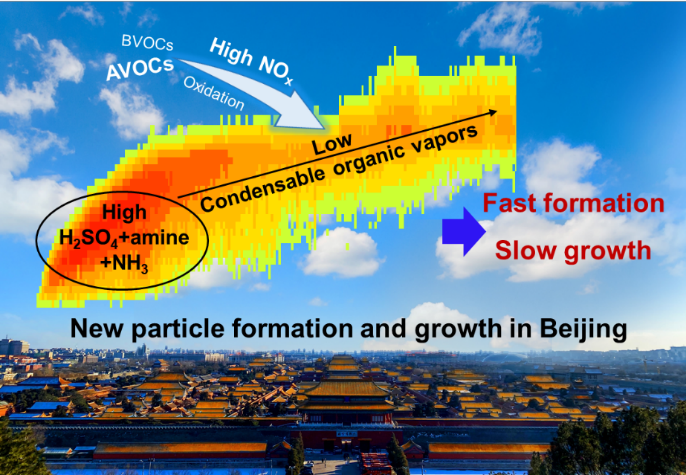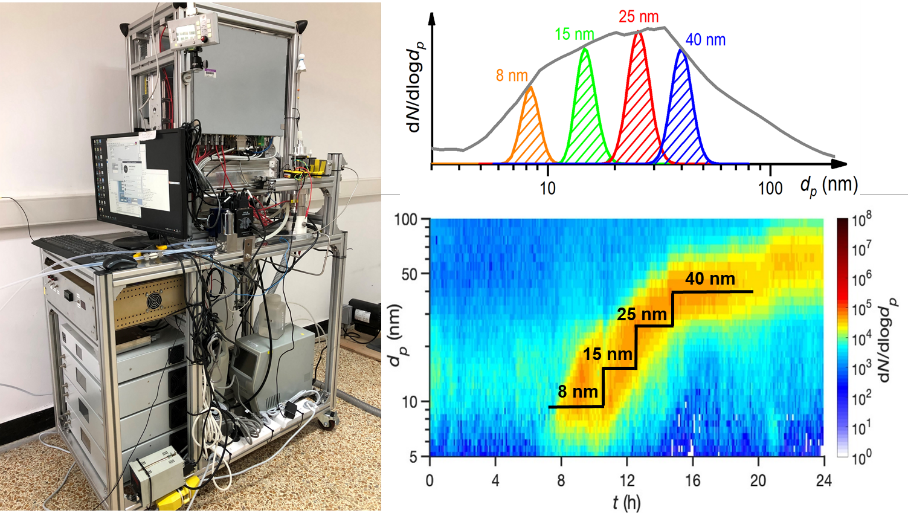Recently, the research group led by Professor Jiang Jingkun of the School of Environment at Tsinghua University has made new progress in the research field of the origins of atmospheric particles. By measuring the chemical composition of 8–40 nm particles during new particle formation events in urban Beijing and combining the observations of gaseous precursors and the modeling of particle condensational growth, the research reveals the important role of condensable organic vapors in the growth of atmospheric new particles.

Schematic diagram of new particle formation and growth in urban Beijing
The research indicates that under the suppression effect of high nitrogen oxide (NOx) levels in Beijing, the concentration of condensable vapors generated by the oxidation of anthropogenic volatile organic gaseous precursors (AVOCs) is relatively low, resulting in the slow growth of new particles. The slow growth is in stark contrast to the high atmospheric new particle formation rate in Beijing.
Atmospheric new particle formation is the process by which gaseous precursors form secondary particles through homogeneous nucleation. It is the main contributor to the global atmospheric particle number concentrations. When newly formed particles grow from 1-3 nm to over 50 nm, they can significantly impact global climate and air quality. The new particle formation rate in heavily polluted urban areas, like urban Beijing, can be 1-3 orders of magnitude higher than those in cleaner areas, while the new particle growth rate in urban Beijing is similar to or even lower than those in cleaner areas. The reasons for this significant difference remain unclear. The small mass and vulnerability of newly formed nanoparticles in the atmosphere make it difficult for traditional instruments to effectively measure their components, hindering the understanding of the new particle growth process.

A picture of the TDCIMS system (left) and the schematic diagram of size-segregated nanoparticle measurement (right)
In collaboration with Professor James N. Smith of the Department of Chemistry at the University of California, Irvine, Jiang Jingkun’s research group combines the newly-developed particle charging technology and soft X-ray chemical ionization technology to build a new version of thermal desorption chemical ionization mass spectrometer (TDCIMS) to achieve online measurement of size-resolved nanoparticle chemical composition (Li et al., Environ. Sci. Technol., 2021, 55: 2859-2868). The study used TDCIMS to measure the chemical composition of particles with the diameters of 8, 15, 25, and 40 nm in Beijing for the first time, exploring the characteristics and mechanisms of atmospheric new particle growth.

Composition of atmospheric new particles (left) and the main particle growth mechanisms as a function of particle diameters in urban Beijing (right).
The study found that, during the initial growth of new particles, the contribution of sulfuric acid condensation was dominant. As the size of the new particles increased, the contribution of condensable organic vapors gradually increased, resulting in the dominance of organics in the particles with diameters larger than 8 nm. The contribution of organic acid-base reactions in particles was relatively small. The condensable organic vapors in urban Beijing mainly come from the atmospheric oxidation process of AVOCs, and the high atmospheric NOx concentrations may inhibit the formation of these condensable organic vapors. Compared to cleaner areas dominated by biogenic volatile organic compounds and lower NOx concentrations, the atmosphere in Beijing contains a large number of volatile nitrophenol compounds, while the proportion of low-volatility, condensable organic vapors is relatively low. This explains the lower atmospheric new particle growth rate in urban Beijing. The low growth rate weakens the impact of high new particle formation rates on climate and air quality. The inhibition of condensable organic vapor formation may weaken in the future with the control of motor vehicles and the reduction of NOx. The research suggests to reduce the emissions of anthropogenic volatile compounds simultaneously to maintain the low new particle growth rate.
The research findings, entitled “Insufficient Condensable Organic Vapors Lead to Slow Growth of New Particles in an Urban Environment,” were published in the American Chemical Society journal Environmental Science & Technology. The first author of the paper is Li Xiaoxiao, a postdoctoral researcher at the School of Environment, under the guidance of academician Hao Jiming and Professor Jiang Jingkun. The corresponding authors of the paper are Professor Jiang Jingkun and Professor James N. Smith. Other collaborating institutions include the University of Helsinki and Beijing University of Chemical Technology.
Paper link: https://pubs.acs.org/doi/10.1021/acs.est.2c01566





